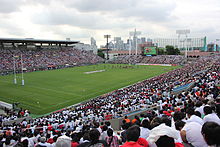Yasuhito, Prince Chichibu
| Yasuhito | |
|---|---|
| Prince Chichibu | |
Bunkyo, Tokyo | |
| Spouse |
Major-General |
| Commands held | 31st Infantry |
| Battles/wars | Second Sino-Japanese War World War II |
Yasuhito, Prince Chichibu (秩父宮雍仁親王, Chichibu-no-miya Yasuhito Shinnō, 25 June 1902 – 4 January 1953) was the second son of Emperor Taishō (Yoshihito) and Empress Teimei (Sadako), a younger brother of Emperor Shōwa (Hirohito) and a general in the Imperial Japanese Army. As a member of the Imperial House of Japan, he was the patron of several sporting, medical, and international exchange organizations. Before and after World War II, the English-speaking prince and his wife attempted to foster good relations between Japan and the United Kingdom and enjoyed a good rapport with the British royal family. As with other Japanese imperial princes of his generation, he was an active-duty career officer in the Imperial Japanese Army. Like all members of the imperial family, he was exonerated from criminal prosecutions before the International Military Tribunal for the Far East by Douglas MacArthur.
Background and family

Born at Aoyama Detached Palace in
On 26 May 1922, Emperor Taishō granted his second son the title Chichibu no miya and the authorization to start a new branch of the imperial family. In 1925, the Prince went to Great Britain to study at
Marriage

On 28 September 1928, the prince married
system in 1884. Prince and Princess Chichibu had no children, as Princess Chichibu's only pregnancy ended in a miscarriage.Military career

Prince Chichibu received his commission as a second lieutenant in the
Prince Chichibu has been implicated by some historians in the abortive
After the coup attempt, the prince and his wife were sent on a tour of
Prince Chichibu Yasuhito was subsequently appointed battalion commander of Thirty-First Infantry Regiment in August 1937, promoted to lieutenant colonel in March 1938 and to colonel in August 1939. During the war, he was involved in combat operations, and was sent to
In a book about
Patronage
After World War II, Prince Chichibu was honorary head of many athletic organizations, and was nicknamed the "sporting Prince" due to his efforts to promote skiing, rugby and other sports. He was also honorary President of both the Japan–British Society and the Swedish Society of Japan. He was a supporter of Scouting in Japan and attended the Fourth International Conference in 1926.[8][page needed]
Rugby union


The prince was also instrumental in securing the development of rugby union in Japan. He was "converted" to rugby after the JRFU president, Shigeru Kayama, returned from a long sea voyage and was able to "market" the game to Prince Chichibu.[9][page needed]
After his death, the Tokyo Rugby Stadium in Kita-Aoyama 2-chome was renamed Chichibunomiya Rugby Stadium. A statue of Prince Chichibu in rugby kit was erected there.
Death
Prince Chichibu died from tuberculosis at his Kugenuma villa in Fujisawa, Kanagawa on 4 January 1953. His remains were cremated and the ashes buried at Toshimagaoka Cemetery (豊島岡墓地), Bunkyō, Tokyo, on 12 January 1953.
Ancestry
| Ancestors of Yasuhito, Prince Chichibu | |||||||||||||||||||||||||||||||||||||||||||||||||||||||||||||||||||||||||||||||||||||||||||||||||||||||||||||||||||||||||||||||||||||||||||||||||||||||||||||||||||||||||||||||||||||||||||||||||||||||||||||||||||||||||||||||||||||||||||||||||||||||||||||||||||||||||||||||||||||||||
|---|---|---|---|---|---|---|---|---|---|---|---|---|---|---|---|---|---|---|---|---|---|---|---|---|---|---|---|---|---|---|---|---|---|---|---|---|---|---|---|---|---|---|---|---|---|---|---|---|---|---|---|---|---|---|---|---|---|---|---|---|---|---|---|---|---|---|---|---|---|---|---|---|---|---|---|---|---|---|---|---|---|---|---|---|---|---|---|---|---|---|---|---|---|---|---|---|---|---|---|---|---|---|---|---|---|---|---|---|---|---|---|---|---|---|---|---|---|---|---|---|---|---|---|---|---|---|---|---|---|---|---|---|---|---|---|---|---|---|---|---|---|---|---|---|---|---|---|---|---|---|---|---|---|---|---|---|---|---|---|---|---|---|---|---|---|---|---|---|---|---|---|---|---|---|---|---|---|---|---|---|---|---|---|---|---|---|---|---|---|---|---|---|---|---|---|---|---|---|---|---|---|---|---|---|---|---|---|---|---|---|---|---|---|---|---|---|---|---|---|---|---|---|---|---|---|---|---|---|---|---|---|---|---|---|---|---|---|---|---|---|---|---|---|---|---|---|---|---|---|---|---|---|---|---|---|---|---|---|---|---|---|---|---|---|---|---|---|---|---|---|---|---|---|---|---|---|---|---|---|---|---|
| |||||||||||||||||||||||||||||||||||||||||||||||||||||||||||||||||||||||||||||||||||||||||||||||||||||||||||||||||||||||||||||||||||||||||||||||||||||||||||||||||||||||||||||||||||||||||||||||||||||||||||||||||||||||||||||||||||||||||||||||||||||||||||||||||||||||||||||||||||||||||
Patrilineal descent
Gallery
-
Prince Chichibu in his twenties, as a second lieutenant
-
Prince and Princess Chichibu Wedding
-
Prince Chichibu in stadium
-
Prince Chichibu at Hirosaki
-
Former villa of Prince Chichibu in Gotemba
-
Statue of Prince Chichibu
-
The hakkō ichiu monument (1940) had Prince Chichibu's calligraphy of Hakkō ichiu on its front side.
Notes
- ISBN 978-0415932141.
- ^ Peter Wetzler, Hirohito and War, University of Hawai'i press, 1998, p.189
- ^ Sheldon Harris, Factories of Death, 2002, p. 142
- ^ Sheldon Harris, Japanese Biomedical Experimentation during the World War II Era, in Military Medical Ethics, volume 2, 2003, p. 469
- ^ P and S Seagrave, Gold warriors, 2002, The Yamato Dynasty, 1999
- ^ Johnson, Chalmers (November 20, 2003). "The Looting of Asia": A review of Gold Warriors: America's Secret Recovery of Yamashita's Gold by Sterling Seagrave and Peggy Seagrave Verso, 332 pages. London Review of Books v. 25, no. 22. Archived from the original on November 19, 2003. Retrieved January 13, 2021.
- ^ Princess Chichibu, The Silver Drum, Global Oriental, 1996
- ^ John S. Wilson (1959), Scouting Round the World. First edition, Blandford Press.
- ISBN 0-7126-0911-3
- ^ "Genealogy of the Emperors of Japan" (PDF). Imperial Household Agency. Archived from the original (PDF) on 22 March 2011. Retrieved 30 March 2011.
References
- Princess Chichibu. The Silver Drum: A Japanese Imperial Memoir. Global Books Ltd. (UK) (May 1996). Trans. Dorothy Britton. ISBN 1-86034-004-0
- Fujitani, T. Splendid Monarchy: Power and Pageantry in Modern Japan. University of California Press; Reprint edition (1998). ISBN 0-520-21371-8
- Lebra, Sugiyama Takie. Above the Clouds: Status Culture of the Modern Japanese Nobility. University of California Press (1995). ISBN 0-520-07602-8
- Scouting Round the World, John S. Wilson, first edition, Blandford Press 1959 p. 67
- ISBN 978-2841861606.
- ASIN B00SQDO3GU.
- ISBN 978-1844675319.
External links
- Their Imperial Highnesses Prince and Princess Chichibu at the Imperial Household Agency website
- Newspaper clippings about Yasuhito, Prince Chichibu in the 20th Century Press Archives of the ZBW








